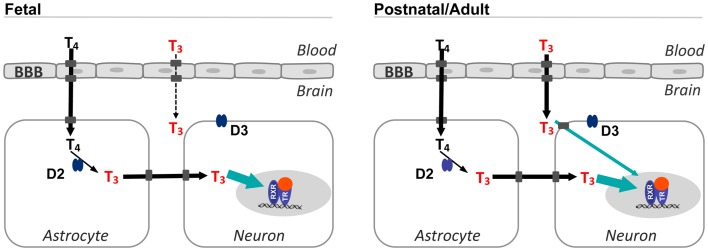Figure 1.
Sources of T3 in the fetal and postnatal brain. T4 from the circulation crosses the BBB and reaches the astrocytes and is converted to T3 by type 2 deiodinase. This is the main source of T3 in the fetal brain. In postnatal and adult animals, T3 from the circulation can also access the brain. The proportion of T3 from the circulation increases up to 50% in the late postnatal stages. In situ T3 production accounts for a high occupancy of thyroid hormone receptors (green arrow), and is also important for expression of genes regulated negatively by thyroid hormone. Transporters in the cell membranes are represented by gray squares, without naming any specific transporter. Although in the rodent brain, the BBB expresses Mct8 and Oatp1c1, the latter is not present in the primate BBB. T4 enters the astrocytes most likely through Oatp1c1. Passage of T3 from astrocytes to neurons is facilitated by Mct8 and also other transporters, since in Mct8 KO mice there is no apparent restriction for the passage of astrocytic T3 to neurons. Type 3 deiodinase is localized in the plasma membrane of neurons. BBB, blood–brain barrier; D2, type 2 deiodinase; D3, type 3 deiodinase; TR, thyroid hormone receptor; RXR, 9-cis retinoic acid receptor.

